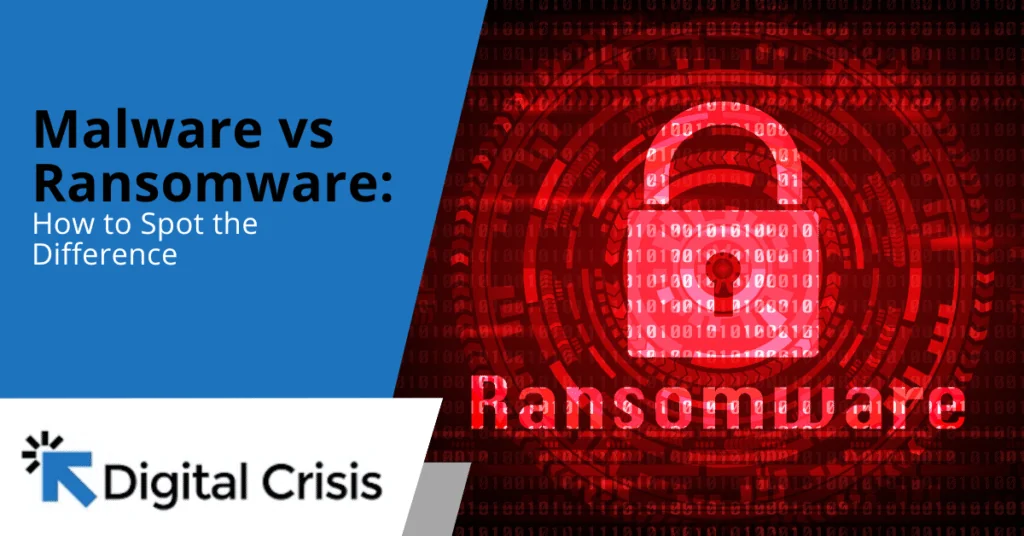Malware vs Ransomware: How to Spot the Difference

Cybersecurity threats keep evolving in the digital world day in and day out. The leading risks are malware and ransomware. While the terms are mostly used interchangeably, they refer to different types of cyber-attacks. For effective protection and response mechanisms, it is very important to understand what sets malware and ransomware apart to protect yourself.
What is Malware?
Malware refers to the general terms used to refer to malicious software, including a wide variety of harmful programs designed to infect and damage computer systems. These programs can take on various forms; each has its own specific purpose and method of attack.
Common Types of Malware
- Viruses: A type of self-replicating program that attaches itself to clean files to spread throughout a computer system
- Worms: Standalone malware that replicates itself to spread to other computers
- Trojans: Malware disguised as legitimate software to be installed by the target unknowingly.
- Spyware: Programs that secretly monitor user activity and gather sensitive information.
- Adware: Software that automatically displays or downloads unwanted advertisements.
Malware can be delivered via multiple vectors-email attachments, malicious websites, and infected USB drives. After installation, malware can do everything from stealing sensitive data to disrupting system operations.
What is Ransomware?
Ransomware is a type of malware that encrypts the victim’s files and makes them unavailable. After this, it demands a ransom payment in return for the decryption key. Such cyber attacks have gained momentum in recent times and have become increasingly sophisticated.
How Ransomware Works
- Infection: Ransomware generally infects a system through phishing emails, exploit kits, or compromised websites.
- Encryption: Once activated, the ransomware starts encrypting files on the infected device and connected networks.
- Ransom Demand: After encryption, a message pops up with a demand for payment, usually in cryptocurrency, for the decryption key.
- Time Pressure: Many ransomware attacks include a deadline, after which the ransom may increase or files may be permanently deleted.
Ransomware attacks can be devastating for individuals and organizations, potentially leading to significant financial losses and reputational damage.
How Do Malware and Ransomware Differ?
While ransomware is a type of malware, there are key differences between the two:
Purpose
- Malware: Can have various goals, including data theft, system disruption, or unauthorized access
- Ransomware: Specifically targets to extort money by holding data hostage
Impact
- Malware: Effects range from minor irritations to crippling system damage
- Ransomware: Data and systems become immediately unavailable; operations are generally shut down
Visibility
- Malware: Often functions in the background to remain undetected
- Ransomware: Announcement of its presence is made quite evident through the ransom demands and locked files
Profit Model
- Malware: Revenue may be realized through data theft, mining for cryptocurrency, or other methods
- Ransomware: Directly demands payment from the victim
What Are the Signs of a Malware or Ransomware Attack?
Being able to recognize the signs of a malware or ransomware attack can be the key to rapid response and mitigation. Some common signs include:
Malware Symptoms
- Slowing down of computer performance
- Appearance of pop-ups or advertisements
- New toolbars or extensions in your browser
- Your homepage or search engine is different
- There is unusual activity on your network
Ransomware Symptoms
- Unable to access files or applications
- Ransom note on screen or in affected files
- File extensions changed to unfamiliar formats
- Unanticipated encryption of files
The impact of malware and ransomware attacks can be greatly minimized by early detection.
How Can You Protect Against Malware and Ransomware?
Protecting your systems from malware and ransomware requires a multi-layered approach:
Prevention Strategies
- Keep software and operating systems up to date
- Use robust antivirus and anti-malware software
- Implement email filtering and web browsing protection
- Educate employees on cybersecurity best practices
- Regularly backup data to secure, offline locations
Response Strategies
- Isolate infected systems to prevent spread
- Report the incident to relevant authorities
- Restore systems from clean backups
- Conduct thorough post-incident analysis
Why is Professional Cybersecurity Support So Important?
Professional cybersecurity support is no longer a nicety but a necessity in today’s threat landscape. A professional cybersecurity expert will be capable of providing:
- Complete risk assessment
- Advanced threat detection and prevention
- Quick incident response and recovery
- Continuous monitoring and support
Protect Your Digital Future Now
It’s a constant battle, but the better you are educated on how to deal with malware and ransomware, the much smaller your risk. Digital Crisis focuses on developing bespoke cutting-edge cybersecurity solutions.
Whether you’re starting from scratch or need an IT refresh, our experts can guide you in keeping your digital assets safe and acting appropriately if bad things happen to your cyber world. Don’t wait for it to happen; instead, reach out to us today and amplify your cybersecurity posture to keep your digital future secure.














